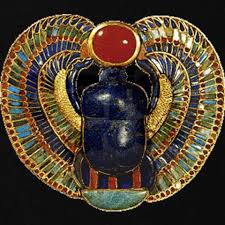The Egyptian Scarab Beetle is a real beetle, a common beetle. To the ancient Egyptians, this common beetle symbolized hope and the restoration of life. They used the design of a scarab beetle in many ways.

Seals were created in the shape of a scarab and used to stamp documents. Artisans made scarab jewelry using precious gems and painted clay. The same design was used to make good luck charms and amulets to ward off evil.
In ancient Egypt, scarab jewelry, good luck charms, and amulets were often given as gifts. An inscription was often added with the name of the owner and perhaps a motto or a message, like, “good luck in your new job”.
Scarabs came in many designs including winged scarabs. The colors were rich and beautiful. Blue symbolized the Nile River. Red symbolized Ra. There were touches of yellow for the desert and sun. Green was used to emphasis growth.
Over time, the scarab became a sacred symbol.
Appearance: The particular species of beetle represented in the numerous ancient Egyptian amulets and works of art was commonly the largely sacred scarab (Scarabaeus sacer). This beetle was famous for his habit of rolling balls of dung along the ground and depositing them in its burrows. The female would lay her eggs in the ball of dung. When they hatched, the larvae would use the ball for food. When the dung was consumed the young beetles would emerge from the hole.
Millions of amulets and stamp seals of stone or faience were fashioned in Egypt depicted the Egyptian Scarab Beetle.
Meaning: It seemed to the ancient Egyptians that the young scarab beetles emerged spontaneously from the burrow where they were born. Therefore they were worshipped as “Khepera”, which means “he comes forth.” This creative aspect of the scarab was associated with the creator god Atum.
The ray-like antenna on the beetle’s head and its practice of dung-rolling caused the beetle to also carry solar symbolism. The scarab-beetle god Khepera was believed to push the setting sun along the sky in the same manner as the beetle with his ball of dung. In many artifacts, the scarab is depicted pushing the sun along its course in the sky.
During and following the New Kingdom, scarab amulets were often placed over the heart of the mummified deceased. These “heart scarabs” (such as the one pictured above) were meant to be weighed against the feather of truth during the final judgment. The amulets were often inscribed with a spell from the Book of the Dead which entreated the heart to, “do not stand as a witness against me.”
Hence the Egyptian Scarab Beetle formed a very important part of Egyptian rituals.